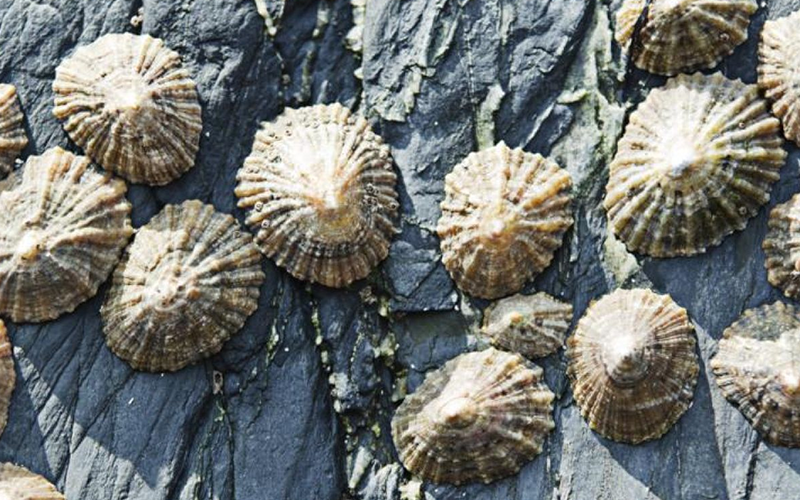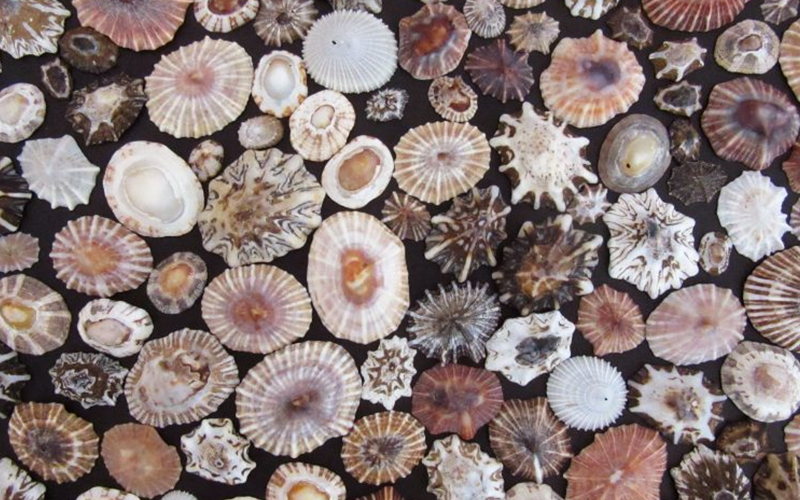
Snail-like creatures with conical shells, native to Europa. While submerged during tiderise, limpets are omnivorous grazers. They usually feed on algae and other aquatic plant life, but they are opportunistic scavengers and can strip a carcass in a matter of hours. During tidefall, they suction themselves in place and clamp down their shell to avoid drying out.
Limpets will continue to grow as long as the resources are available, so they can range from the size of a pinky nail all the way up to the size of a house——though such large limpets are rare due to predation. Much like the rings of a tree, the ridges of a limpet shell can be used to determine its age and to identify historical patterns of resource availability, especially on older specimens.
Anatomy
The limpet’s shell protects a muscular, three-lobed foot-body. The inner surface of each foot is lined with rows of rasp-like “teeth” oriented towards a central mouth where the lobes meet, allowing the limpet to nibble away at anything they pass over.
They possess a highly effective kidney-like mantle that spreads across their entire body just beneath the shell. This membrane allows them to consume otherwise poisonous substances, such as algae blooms——although this makes the limpet temporarily inedible due to the concentration of toxins in the organ. If butchered so as to keep this membrane intact, it can be used as a filter.
Predation
The limpet’s natural predator is the mud flea. This tiny insect bypasses the protective shell by tunneling up through the mud of the tidebed and gnawing their way into the soft foot-body. After feasting on the limpet’s insides, they lay their eggs inside the carcass.
The rapid life cycle of the mud flea and the massive number of eggs laid by a single specimen means that an infestation can rapidly wipe out an entire population of limpets. Tidal nomads who find a flea-infested limpet——identifiable because their shell can be lifted even at tiderise——will flip the corpse over, trapping the flea larvae in the shell and preventing them from spreading through the remainder of the local limpet population when they hatch.
The ubiquitous limpets are one of the few sources of food in the tidelands and the tidal nomads consume them in endlessly varied preparations. Though nearly impossible to pry from the ground during tidefall, they can be deceived into releasing their hold through specific vocalizations that mimic the incoming tide.
For smaller limpets, a single person humming can be sufficient; however, the larger the limpet, the greater the magnitude and complexity of the vocalizations must be. This has led to a unique “hunting” practice with roots in the worm calling of the wormseers, where an entire clan circles a large limpet and performs what is essentially an acapella rendition of the sea.
Lastly, while submerged during tiderise, limpets are sometimes preyed upon by other limpets. A specimen of sufficiently larger size can completely cover another, latching their feet around the circumference of the smaller shell and applying equilateral force to “pop” its suction.
Notable Varieties

Common limpets can be found almost anywhere in the tidelands, with patterned shells in shades of brown, red, and purple. When pulverized and boiled, these shells produce a reddish-purple dye that is commonly used in the attire of the tidal nomads. Their flesh has a savory, mushroom-like quality.
Rock limpets are very similar to common limpets, except that they live exclusively on rocky surfaces. This habitat protects them from attack by mud fleas, but limits their size. They remain smaller than common limpets even if moved to the same habitat and typically fail to thrive, suggesting that the size difference is early genetic speciation open_in_new rather than being solely environmental.
The tall, narrow shells of tall limpets, usually in shades of cream to pinkish beige, protect them from predation by other limpets by preventing them from being crawled over. Although this shape also makes them easier for humans to dislodge from the tidebed by force, they can also spit a stream of water intended to disorient predators long enough for the limpet to clamp back down. Since they have comparatively little meat for their size, they’re generally not considered to be worth the trouble.
Hunter limpets are large in size, and their shells have a pitted, irregular surface with mottled brown and gray coloring. They are more actively predatory than other varieties, and have been observed moving——even during tidefall——to trap living creatures beneath their shell. Their flesh is extremely flavorful due to this rich diet.
There was an incident where an especially large hunter limpet opportunistically trapped a nearby child beneath its shell. The limpet could not be sung up while eating, and could not be dislodged due to its size, so the child was consumed over the course of several hours while their clan helplessly struggled to free them. This led to the saying that children should never go near a limpet that is larger than they are.
Early limpets have a more pronounced hexagonal shape and light coloring similar to tall limpets. The irregular rim of their shell causes a poorer seal when clamped down, making this variety more prone to dehydration; because of this, they have a preference for the earliest tidelands where they are near the sea even at tidefall. Their silky flesh is considered a delicacy and usually consumed raw, though they are risky to acquire due to their remote habitat.